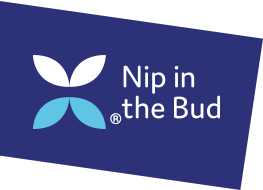Child Mental Health Conditions
Mental health problems in children are quite common. About one in ten children aged between five and sixteen are diagnosed with a problem every year and about 75% of mental illnesses are thought to start before the age of 25.
Sadly, it’s often the case that a child will go untreated with significant consequences to that young person’s life, to their family and community. Nip in the Bud wants to change that. We believe that with more information and the right resources, we can improve outcomes, giving all children a happier and healthier life.
Find out more about the most common childhood mental health conditions.
Self-Harm
Self-Harm is when you hurt yourself as a way of dealing with very difficult feelings, painful memories or overwhelming situations and experiences. It can be the acute reaction people turn to when they feel they have no other option.
Self-Harm affects more people than you might think. It is estimated that between 10%-20% of all people self-harm at some point during their lifetime. It is hard to gather exact figures due to the stigma surrounding self-harm, and because people try to hide their wounds, scars and bruises.
The average age of the first incident of self-harm is around 12/13, though the rate of self-harm among younger children (aged 9-12) in the UK has increased in the last ten years.
OCD in Children
Obsessive Compulsive Disorder (OCD) is thought to occur in between 1-4% of the child and adolescent population. In real terms that could mean that in an average primary school of 500 pupils there could be between 5 and 20 young people struggling with OCD.
OCD is a serious condition that can cause major disruption to the lives of young people and their families. OCD tends not to go away on its own and without treatment it is likely to persist into adulthood. In fact, many adults who receive a diagnosis of OCD report that some symptoms started during childhood.
Anxiety in Children
Anxiety disorders are one of the most common mental health problems identified in children. Estimates of the rates of prevalence vary greatly from 8% to 27% lifetime prevalence by age 18.
Chronic anxiety disorders are associated with increased risk of other serious mental health problems in later life. Therefore, early identification and treatment is key.
Autism Spectrum Condition in Children
Autism spectrum condition (ASC), is the preferred name for what is formally known as autism spectrum disorder (ASD). ASC is not technically a mental health disorder; it is a neurodevelopmental condition. However, as 70% of people with ASC develop at least one co-occurring mental health issue, and 40% of these will develop more than one, early recognition is key.
ASC in children varies widely, but typically affects three main areas of functioning: communication, social interaction and behaviour.
Autism is not an illness; it is a spectrum condition that will vary across each area and therefore affect each person differently.
ADHD in Children
ADHD stands for Attention Deficit and Hyperactivity Disorder.
It is characterised by difficulties in the areas of attention, level of activity and impulse control. These difficulties are present before the age of 7 years and can affect many areas of the child’s and family’s life.
It is sometimes called “hyperkinetic disorder”. It is also, at times, referred to as “attention deficit disorder” (ADD) if problems are mainly due to difficulties with attention rather than overactivity.

